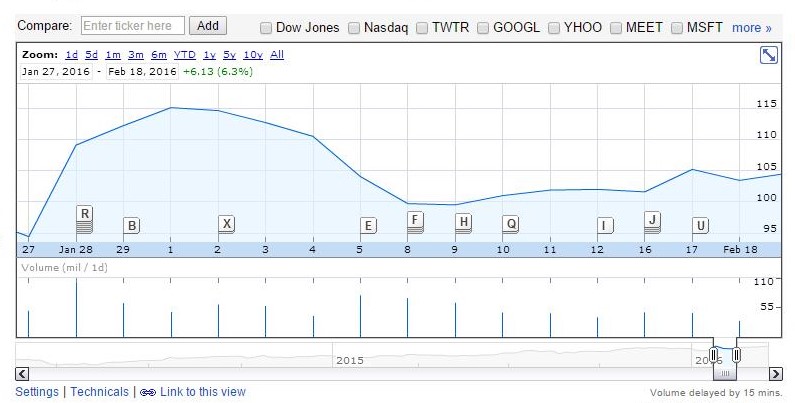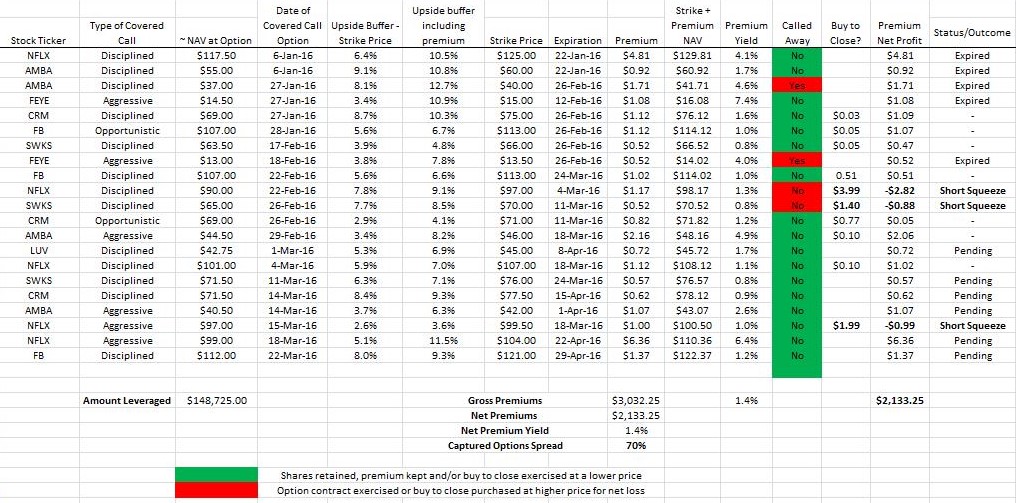Introduction
Leveraging covered call options in opportunistic or conservative scenarios may augment overall portfolio returns while mitigating risk in a meaningful manner. In brief, options are a form of derivative trading that traders can utilize in order to initiate a short or long position via the sale or purchase of contacts. A call option is a contract which gives the buyer of the contract the right, but not the obligation, to buy the underlying security at a specified price on or before a specified date. The seller has the obligation to sell the underlying security if the buyer exercises the call option. A call option gives the owner (buyer) the right to buy the security at a specific price is referred to as a call (bullish); an option that gives the right of the owner to sell the security at a specific price is referred to as a put (bearish). In the event of a covered call, this is accomplished by leveraging the shares one currently owns by selling a call contact against those shares and collecting a premium. I will provide an overview of the theory vs. empirical practice based on my covered call activity during Q1 2016. Here, I’ll provide details focusing on optimizing stock leverage via covered calls. Emphasizing the ability to sell these types of options in an opportunistic, aggressive and disciplined manner to generate liquidity while accentuating returns and mitigating risk via empirical data.
A Few Characteristics To Keep In Mind For Covered Call Options Trading
1. Strike price: Price at which you can buy the stock (buyer of the call option) or the price at which you must sell your stock (seller of the call option).
2. Expiration date: Date on which the option expires
3. Premium: Price one pays when he/she buys an option and the price one receives when he/she sells an option.
4. Time premium: The further out the contact expires the greater the premium one will have to pay in order to secure a given strike price. The greater the volatility the greater the time premium received for covered call writing.
5. Intrinsic value: The value of the underlying security on the open market, if the price moves above the strike price prior to expiration, the option will increase in lock-step.
My Characterization Of And Types Of Covered Calls
1. Opportunistic: When a stock price increases dramatically based on earnings or an extraneous event in the range of 7%-15% in one day or over the course of a few days.
2. Aggressive: Writing a covered call at risk near the money in order to lock in a high yielding premium. Relinquishment of shares not an issue as the security of interest is not a long holding.
3. Disciplined: Writing far out of the money covered calls with a substantial upside buffer to mitigate risk of relinquishment and capture small spreads over long periods of time as this is an iterative process. The upside strike buffer should be in the range of 7%-10% for one-month contracts while being cognizant of the stock price as it approaches expiration.
The Potential To achieve The Best Of Both Worlds Via Disciplined Covered Call Writing
Can one be long an equity position while writing covered calls against his position to yield a scenario where at the expiration of the contract the strike price is not reached thus retaining the shares, premium and any dividend rights? I will walk readers through a multi-tiered approach to leveraging different types of covered calls that I employ on a frequent basis to optimize my returns on long positions. If one is long a stock and has healthy unrealized gains, he may elect to write a covered call against his position to extract additional appreciation. Writing a covered call far enough out-of-the-money will likely lock in a cash premium on the front end with a low risk of relinquishing shares on the back end. Thus, the premium, shares and any dividends are retained and now the ability to write another covered call against this equity position is now available. This recalibrating of strike prices as the underlying equity appreciates enables traders to ride the uptrend on a bi-weekly or monthly basis. The idea here is to allow enough of an upside buffer that is built into the strike price relative to the stock price at the time the covered call is written depending on the scenario. This will likely result in a very low-risk scenario that shares will be relinquished at expiration while maintaining a long position. A soft upside buffer target that I focus on is 7%-10%. Thus, shares have another 7%-10% to run over the course of roughly a month in order to reach the strike price and risk relinquishment. This soft rule of thumb can be scaled as needed based on time, volatility and recent price swings to the upside.
Selling Opportunistic Covered Calls
During the week of Jan 27th, Facebook reported blowout numbers and the stock appreciated 21% going from $95 on Jan 27th to $115 on Feb 1st (Figure 1). I wanted to capitalize on this uptrend as Facebook broke through its respective 52-week highs. For this opportunistic options trade, I targeted my soft 7%-10% upside buffer factored into the strike price. For my Facebook position, a 5.6% upside was built into the strike price ($113 strike - $107 at option) and factoring in the premium of $1.12 I arrived at a 6.7% upside buffer. In this case, for a long position, this 6% buffer was appropriate considering this trade was an opportunistic covered call. I was able to remain in the position while extracting value via out-of-the-money covered call option writing after the overall uptrend in the stock (Table 1).

Figure 1 – Google Finance Facebook stock movement from $95 to $115 after earnings in Jan of 2016

Table 1 – Details surrounding my covered calls through mid-March 2016
Premiums Received To Augment Returns
Based on my scenario above, extracting ~1% realized a gain on a monthly basis per equity holding via writing far out-of-the-money covered calls doesn’t seem like much on the surface, however, extrapolating out on an annualized basis may augment returns by 10%-15%.
The Short Squeeze
The major risk to this approach is attributable to any potential gains beyond the strike price. Put another way the call seller takes on the risk of relinquishing his shares at an agreed upon price by an agreed upon date while receiving a premium to take on this risk of relinquishment. Thus, any price appreciation beyond the strike price will result in unrealized gains and relinquishment of shares at the strike price plus the premium received at the time of selling the call contact. The option seller has the ability to buy-to-close at a higher price as the intrinsic value appreciates beyond the strike price. If one elects to purchase back the contact at a higher price than originally sold then, a short squeeze occurs. In order to substantially reduce this risk for a long investor that wishes to extract value throughout holding the underlying security will need to focus on writing far out-of-the-money covered calls. Using my example above and my soft upside buffer of 7%-10% you can see that this allows plenty of upside while extracting a ~1% cash premium on a monthly basis. This buffer will substantially decrease one’s risk of relinquishing his shares.
The Power Of Closing Out Contracts (Buy-To-Close)
One of the advantages of writing covered calls is the ability to buy back the contact (buy-to-close) at a lower price and capture the spread prior to expiration. As the stock declines the underlying option will decline as well thus as a stock fluctuates throughout the contact timespan, the seller can cancel the contract via buying to close the option position (buy-to-close). Facebook peaked at $117 and fell back down into the mid-$100 range (far from the $113 strike price) and in a combination of the time premium evaporating this option that I sold for $1.12 was now worth $0.05. I elected to cancel the option and buy-to-close the contact for $0.05, capturing a spread of $1.07 and retaining the shares (Table 1). This method accelerates closure of contracts to free up shares to no longer run the risk of relinquishment and the ability to write another covered call on the same underlying security.
A Few Questions/Comments To Consider Prior To Selling Covered Calls As Long Investors
1. As a long investor, would you be content with relinquishing your shares at the agreed upon strike price plus the premium if shares reach the strike price by expiration?
2. Chasing premium yield will likely result in a much higher risk of relinquishing shares thus it is important to remain disciplined and write far out-of-the-money covered calls with a generous upside buffer of ~10% to capture ~1% premium on monthly contacts.
3. Even if shares are called away, guaranteed money (strike price plus premium) was placed into your account. These funds can be used to add to other positions on pullbacks or to initiate the same position if the stock comes down at a lower entry point.
Conclusion
The covered call option can serve as an opportunistic, aggressive or conservative way to utilize options to mitigate risk, generate cash via premiums and augment portfolio returns. Specifics surrounding an appropriate upside buffer and premium yield for long investors is outlined above depending on the scenario. Important points to selling covered calls and extracting value via stock leveraging as long investors are outlined as well. This is a meaningful way to accentuate portfolio returns if the stock of interest decreases in value, trades sideways or trends upward (without crossing the strike price threshold) as the premium will be kept despite any of these outcomes. To offset the risk of losing out on potential appreciation, the option seller is paid a cash premium that is deposited into the option seller’s account and never relinquished. Taken together, the owner of an underlying security can leverage his/her shares in a meaningful manner to mitigate risk and augment portfolio returns. This can be performed in a variety of ways as long as the options are sold out-of-the-money. This exercise can be repeated on a monthly basis for small yields that can be very impactful to any portfolio over the long-term. Thus far in Q1 of 2016 I’ve had a few short squeezes however these were confined to more volatile stocks with less predictable outcomes and market upswings near expiration of the contacts. On an empirical basis, taking into account my pending option contacts, I’ve been able to capture 70% of all premiums and a 1.5% yield on the leveraged capital (Table 1). I will update readers periodically on my options updates.
Thanks for reading,
The INO.com Team
Disclosure: The author currently holds shares of FB, CRM and SWKS and the author is long all these positions. The author has no business relationship with any companies mentioned in this article. This article is not intended to be a recommendation to buy or sell any stock or ETF mentioned.
